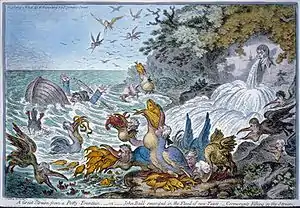Henry Petty-Fitzmaurice, 3rd Marquess of Lansdowne
Henry Petty-Fitzmaurice, 3rd Marquess of Lansdowne, KG, PC, FRS (2 July 1780 – 31 January 1863), known as Lord Henry Petty from 1784 to 1809, was a British statesman. In a ministerial career spanning nearly half a century, he notably served as Home Secretary and Chancellor of the Exchequer and was three times Lord President of the Council.
Background and education
Lansdowne was the son of Prime Minister William Petty, 1st Marquess of Lansdowne (better known as the Earl of Shelburne) by his second marriage to Lady Louisa, daughter of John FitzPatrick, 1st Earl of Upper Ossory. He was educated at Westminster School, the University of Edinburgh, and Trinity College, Cambridge.[1][2]
Political career
He entered the House of Commons in 1802 as member for the family borough of Calne and quickly showed his mettle as a politician. In February 1806 he became Chancellor of the Exchequer in Lord Grenville's Ministry of All the Talents, being at this time member for the University of Cambridge, but he lost both his seat and his office in 1807. In 1809 he became Marquess of Lansdowne, and in the House of Lords and in society he continued to play an active part as one of the Whig leaders. His chief interest was perhaps in the question of Roman Catholic emancipation, a cause which he consistently championed, but he sympathised also with the advocates of the abolition of the slave-trade and with the cause of popular education. Lansdowne, who had succeeded his cousin, Francis Thomas Fitzmaurice, as 4th Earl of Kerry in 1818, took office with Canning in May 1827 and was Secretary of State for the Home Department from July of that year until January 1828.[1]
He was Lord President of the Council under Earl Grey and then under Lord Melbourne from November 1830 to August 1841, with the exception of the few months in 1835 when Sir Robert Peel was prime minister. He held the same office during the whole of Lord John Russell's ministry (1846–1852), and, having declined to become prime minister, sat in the cabinets of Lord Aberdeen and of Lord Palmerston, but without office. In 1857 he refused the offer of a dukedom, and he died on 31 January 1863. Lansdowne's social influence and political moderation made him one of the most powerful Whig statesmen of the time; he was frequently consulted by Queen Victoria on matters of moment, and his long official experience made his counsel invaluable to his party.[1]
Other public appointments
Lansdowne chaired the inaugural meeting of the London Statistical Society, and was its first president (1834–1836). He later served a second term (1842–1844). (See The Times 15 and 17 March 1834, and John Bibby (1987) HOTS: History of Teaching Statistics.)
Family
Lord Lansdowne married Lady Louisa Fox-Strangways, daughter of the 2nd Earl of Ilchester, in 1808. She died in April 1851, aged 65. Lord Lansdowne died in January 1863, aged 82. His eldest son, the Earl of Kerry, had predeceased him and he was succeeded in the marquessate by his eldest surviving son Henry. The latter was the father of Henry Petty-FitzMaurice, 5th Marquess of Lansdowne, who also became a distinguished statesman.
References
-
 One or more of the preceding sentences incorporates text from a publication now in the public domain: Chisholm, Hugh, ed. (1911). "Lansdowne, William Petty Fitzmaurice, 1st Marquess of s.v. Henry Petty Fitzmaurice". Encyclopædia Britannica. 16 (11th ed.). Cambridge University Press. p. 184.
One or more of the preceding sentences incorporates text from a publication now in the public domain: Chisholm, Hugh, ed. (1911). "Lansdowne, William Petty Fitzmaurice, 1st Marquess of s.v. Henry Petty Fitzmaurice". Encyclopædia Britannica. 16 (11th ed.). Cambridge University Press. p. 184. - "Fitzmaurice, Lord Henry Petty (FTSY798HP)". A Cambridge Alumni Database. University of Cambridge.
External links

- "Archival material relating to Henry Petty-Fitzmaurice, 3rd Marquess of Lansdowne". UK National Archives.

 Obituary in Illustrated London News, 14 February 1863.
Obituary in Illustrated London News, 14 February 1863.- Hansard 1803–2005: contributions in Parliament by the Marquess of Lansdowne

.svg.png.webp)